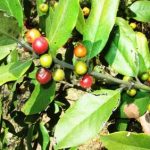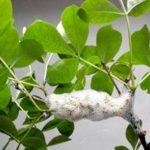TREE LIFE
April 2014
MASHONALAND CALENDAR
Sunday, 13th April – PLEASE NOTE DATE – OUTING TO CAROLINA WILDERNESS: Leave Harare on the Beatrice/ Masvingo road, go through the tollgate & across the Manyame River bridge. We will meet at 09.30 as usual. Bring all that you need for lunch, plus hats, chairs and tables.
Saturday, 26th April: No outing
SUBS DUE BEFORE THE A.G.M. – NOW $10
It’s the time once again to pay your annual subscription to the Tree Society. Please note subs are now $10 per person / per family and should be paid before the A.G.M. if you would like to be included amongst the voters. Subs can be paid as follows:
- Deposit direct to our CABS account number: 1002549477 (preferable). The account name is “W.R. Clarke Tree Society”. If you do make a deposit to CABS, please make sure your name is reflected as a reference, and also advise the Treasurer (wrc@mweb.co.zw) by email of the date of your deposit.
- In person to the Treasurer, Bill Clarke at Val D’Or, near Arcturus; or to the Chairman, Mark Hyde (29, Harry Pichanick Drive, Alexandra Park, Harare; tel: Harare 745263; email: mahyde@gmail.com; or to any Tree Society Committee member.
- Payments can also be accepted at any of our outings.
– Ed
TREE OF THE MONTH
Julbernardia globiflora
Family: Fabaceae – Caesalpinioideae
Common names: Munondo; Nd: Ishungu, Umtshonkwe; Sh: Munondo.
This tree was named after Jules Bernard, a former governor of Gabon.
The family Caesalpinioideae is a sub-family of the Fabaceae family.
As mentioned many times before, the Fabaceae family is huge and has been subdivided in three sub-families; in Southern Africa alone we count over 30 species in the Caesalpinioideae family. The group is difficult to characterise: the Mimosoideae (Acacia) have mimosa-like flowers, either pom-pom or elongated spikes; the Papilionoideae have characteristic asymmetric sweet-pea shape flowers; and if they are neither think of Caesalpinioideae. When there are no flowers it is generally possible to eliminate Mimosoideae if the leaflets are very small and the leaves bipinnate (apart from Peltophorum africanum which is a member of the Caesalpinioideae). When all else fails, I refer to Sauvignon.com. and become a treetotaller.
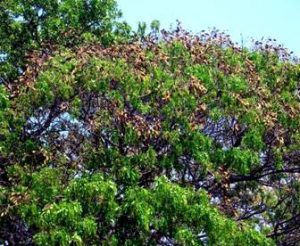
Julbernardia globiflora
Julbernardia is a well rounded tree growing to some 18 meters in height. As it is a constituent of the Miombo woodlands it must not be confused with Brachystegia spiciformis. Both have similar paripinnate leaves but Julbernardia generally has more leaflets. Most important, in B. spiciformis the last pair is always the largest, but never in Julbernardia. Another easy way to tell them apart is the way the pods grow. The Brachystegia pods grow all over the tree, whereas Julbernardia is a botanical Medusa, with all pods protruding outside the crown.
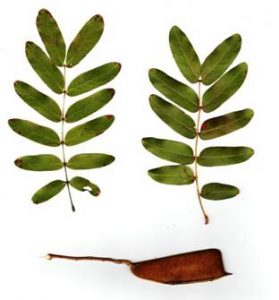
Julbernardia globiflora leaves and pod
The leaves of Julbernardia are paripinnate with 4 or 6, sometimes 8, pairs of opposite leaflets; rachis velvety; leaflets oblong to oblong-lanceolate, dark green, both surfaces finely hairy, margin entire and ciliate, apex rounded, sometimes slightly notched; the base is broadly tapering and asymmetric. The petioles are around 3 cm long and velvety.
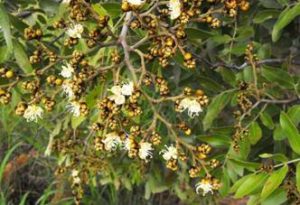
Julbernardia globiflora flowers
The flowers are white and borne in January in stout, dark-brown hairy panicles. The pod is a hard woody pod dehiscing explosively in September.
An interesting feature of this tree is its susceptibility to invasion by Berlinianche aethiopica. Berlinianche is a holoparasite, vegetatively much reduced. The only visible parts are the flowers pushing through the bark.
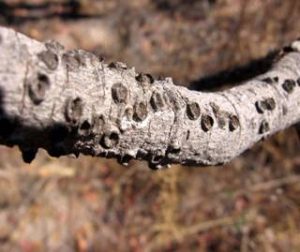
Berlinianche aethiopica buds on bark of Julbernardia globiflora
The flowers (at least the female flowers, the plant being monoecious) are numerous and showy, clustered, sessile, 2 to 2.5 mm in diameter, hemispherical, bright blood-red turning brown and short lived producing a globose berry.
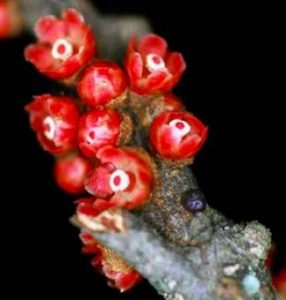
Berlinianche aethiopica flowers on bark of Julbernardia globiflora
The wood of Julbernardia planes to a highly lustrous finish. Unfortunately it is very prone to attacks by borers and termites and it’s durability is poor. It is used in furniture making and also, in times past and surprisingly enough, for railway sleepers. Medicinally it is used to treat diarrhoea and conjunctivitis.
Sources:
Flora of Zimbabwe website: www.zimbabweflora.co.zw.
Plantzafrica website: www.plantzafrica.com;
Conservatoire et Jardin Botaniques Ville de Geneve: https://www.ville-ge.ch.
Coates Palgrave, K. 1977. Trees of Southern Africa. Struik, Cape Town.
Goldsmith, B. & Carter, D.T. 1992. The Indigenous Timbers of Zimbabwe. Forestry Commission, Harare.
Mullin, L.J. 2006. A New Zimbabwean Botanical Checklist of English and African Plant Names. Tree Society of Zimbabwe, Harare.
Van Wyk, B. & Van Wyk, P. 1997. Field Guide to the Trees of Southern Africa. Struik, Cape Town.
Wild, H. A 1972. Rhodesian Botanical Dictionary of English and Native Plant Names. Govt. Printer, Salisbury.
– JP Felu
OUTING TO MCDONALD TIMBERS 16th March 2014
My sister Zilla and I arrived at the farm just after 09:00 and were met by Kim McDonald who invited us to wander around his amazing garden. By 09:45 we began to wonder if anyone else was coming, but just before 10:00 Bilal arrived with Tom Muller and by 10:30 or so we had a total of 11, some of whom had got a bit lost. A new member, Buks Conradie, came all the way from Mvurwi.
We explored areas of miombo woodland on both sides of the dam. Brachystegia spiciformis & Julbernardia globiflora predominated but Tom insisted that nobody could go home until we had at least 25 species. He also informed the ladies that they would be the ones to climb the trees for leaf specimens! In the end we had a list of 33 plus some unknowns which hopefully by now Tom will have identified. The foliage of one was way out of reach and the tree unclimbable but we managed to obtain a small specimen by hurling the buckle end of a long nylon towrope into the canopy and jerking it down; the leaves were simple and fairly small (4 to 5 cm), fresh green in colour and softly velvety; amongst them were small dried-up inflorescences which could once have been umbels, maybe.
The trees identified were typical of sandveld and many were very small. Mark would have been in his element with all the non-arboreal plants including more than one Vernonia (the cornflower-blue ones, particularly attractive) and a few of those tiny sensitive plants whose name escapes me but which omission I’m sure Mark will rectify. Tom was quite excited about this and took away a complete plant.
Picnic lunch was enjoyed in a pleasant rocky area before we all made our various ways home.
– Dave Hartung
Outing to McDonald Timbers: footnote
Tom collected various specimens on the outing and these were kindly identified by the National Herbarium staff as follows: Biophytum umbraculum (formerly B. petersianum). This was a tiny plant (2 cm high) with sensitive leaves. Grewia decemovulata; Rhus longipes; Rhus tenuinervis; Rhoicissus tomentosa [This is a surprising one to me. It is primarily an Eastern Districts species, but it does come westwards along the Central Watershed – but I would be surprised if it comes as far as Ruwa – Mark]; Psydrax livida; Adenia gummifera – climber with succulent stem; Tinospora caffra – another climber, with a kidney-shaped leaf; Indigofera arrecta – shrub c. 1 m high; Clerodendrum eriophyllum (formerly C. glabrum). Unusually large multi-trunked specimens reaching 12-15 metres in height.
– Mark Hyde
CANONKOPJE GAME AND CRANE SANCTUARY
16 February 2014
This was my first visit to Cannonkopje Game and Crane Sanctuary near Mtoroshanga and if the Tree Society has ever visited it before it was many years ago.
Nowadays it is most unusual for the Tree Society to be heading into the farming areas to the north of Harare (once the staple source of outings for the Society) and also unusual for us to undertake such a long journey (2 hours from Harare).
After so much recent rain, I was a bit worried about the possible state of the roads and especially the crossing of the Muzare river, which Rolf had warned me it was best to take slowly after rain in order to avoid sliding off, but I needn’t have worried; the roads were in a good state, assisted by a few dry days.
About 18 members attended. Unfortunately, Rolf Hangartner, the owner, could not be present but we were ably hosted by the warden, Jerasi Kawundura and senior scout Canaan Kaputeni.
The Sanctuary is at 1270 m altitude, a bit lower than Harare, and this could be detected in the range of trees seen. We were very fortunate to have Tom Muller with us to lead the party.
We set off towards the base of a nearby kopje (Chivarairwa kopje) and even before leaving the fenced area around the main house, we immediately started to record a significant number of woody species. For example, there were no fewer than 11 species concentrated around a very small termite mound.
As we approached the base of the kopje, we entered thicker, more shaded bush. A flowering Pterocarpus caught our attention and closer examination showed it to be P. rotundifolius, but not the usual subsp. rotundifolius we see around Harare, but subsp. martinii. This has many more leaflets (9-13) compared to subsp. rotundifolius (3-7). Nearby was a specimen of the Pink jacaranda, Stereospermum kunthianum, with its distinctive bark; the leaves are imparipinnate and often the rhachis is angled and not flat.
Here amongst the leaf litter were specimens of a small white-flowered orchid, Disperis anthoceros and we saw it again later further up the kopje.
We then emerged onto an open rocky slope with some seepage zones with some interesting herbs. Nearby was a fine Sterculia quinqueloba and growing out of a crack in the rocks, the Paperbark commiphora, Commiphora marlothii.
Resuming our climb, which had become steeper by now, we found ourselves in a fairly typical rocky flora which included Erythroxylum emarginatum and Canthium lactescens. Diospyros nummularia, with its distinctive almost circular, shiny leaves, was present in shady places among the rocks. There were also Ficus glumosa, Maytenus undata, Tetradenia riparia, Ficus natalensis subsp. graniticola, Mimusops zeyheri and Apodytes dimidiata. A slightly more surprising tree amongst the rocks was Trichilia emetica, the Natal mahogany; it’s generally a medium to low altitude species, but 1310 m is quite high.
A slightly more unusual species seen was Erythrococca trichogyne. I suspect that this is not particularly rare; it’s just easily overlooked, especially when it is neither flowering nor fruiting as was the case here.
At the highest point we reached, which was still some way below the summit, there was a colony of red-flowered Mirabilis jalapa – the Marvel of Peru – which is of course an exotic. Generally the habitat was in reasonably good condition without many introductions and it seemed surprising to see it there.
In the shade of the rocks was a large stinging nettle, Girardinia diversifolia. We also observed a tendrillar climber, Helinus integrifolius.
We then descended for a late lunch. A group went to visit to the cranes and afterwards in the middle of the afternoon we gathered for tea, which included a Swiss delicacy, Nusgipfel. This was a delicious pastry containing a filling made with nuts.
Afterwards the party headed back to Harare.
The venue is an interesting place and we hope to make a return visit. Tom knows of a swamp forest there which contains interesting species and that should perhaps be the focus of our next visit.
Our thanks go to Tom for leading, Rolf for the invitation and Jerasi and Canaan for accompanying us throughout the day.
– Mark Hyde
THE STEINDLS’ GARDEN
22 February 2014
Saturday afternoon saw a group of Tree Society members exploring the trees, both indigenous and exotic, in the garden of Rudi and Barbara Steindl at 39, Taunton Road, Mandara.
I find identifying plants in a garden quite challenging. In particular, the potentially worldwide origin poses difficulties. Nowadays though, the internet is helpful not only because there are now numerous pictures of garden plants online but also because there is greater access to the literature, although much remains behind paywalls.
However, even if the name can be found, it can be difficult to find further, detailed, information about the plant.
A case in point is the very attractive red-flowered shrub, Jatropha integerrima. This is common in Harare gardens and was present in this one. The family is Euphorbiaceae which generally has unisexual flowers. The question is – what is the arrangement of the sexes? Are they on separate plants or in different places on the same plant? No literature I possess answers that question.
To return to the afternoon walk, there were some nice indigenous trees in the garden including a large specimen of Ekebergia benguelensis. This has 1-pinnate leaves which are imparipinnate, discolorous (i.e. paler beneath) and crowded at the ends of the branches. We also saw Diospyros lycioides subsp. sericea and Pavetta gardeniifolia. There was also a female tree of Uapaca kirkiana.
We also came across Syzygium jambos, the Rose apple. This is native to SE Asia and appears to be frequently grown in Zimbabwean gardens and is occasionally known to escape into the wild. It has large slightly greenish-white flowers, 5-8 cm across and bears numerous, long showy stamens. The fruits are berries 2-5 cm long.
We also found the common cultivated fig, Ficus carica. This has distinctive 3-5-lobed leaves. It is native to the Mediterranean region but is widely cultivated and will grow out of doors even in areas prone to frost such as the UK.
Another shrub seen was Duranta repens. This is well-known to the Society both in and out of gardens. Here we came across a distinctive cultivar which we first saw on our Dandaro walk last year. This has deep blue-purple flowers and the petals have a strong white margin; it’s a much more garden-worthy plant than the varieties we normally see. Thanks to Mick Fleet, I now know that this is the cultivar ‘Sapphire Showers’.
A small tree which defeated us on the recce, when it had been in fruit only, was now in flower and turned out to be the widely grown Leucaena leucocephala. It belongs to the subfamily Mimosoideae of the Fabaceae and has 2-pinnate leaves and flowers in heads rather like an Acacia. However it lacks the spines of acacias. This also escapes into the wild from time to time but does not seem to have become a serious invader.
All in all it was an interesting afternoon with plenty of material to discuss and debate. I would like to thank the Steindls for hosting us and also for generously providing us with tea, sandwiches and cake at the end of the walk.
– Mark Hyde


